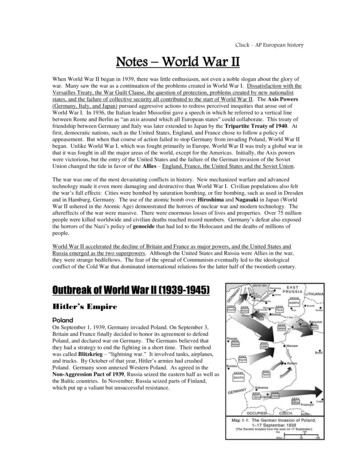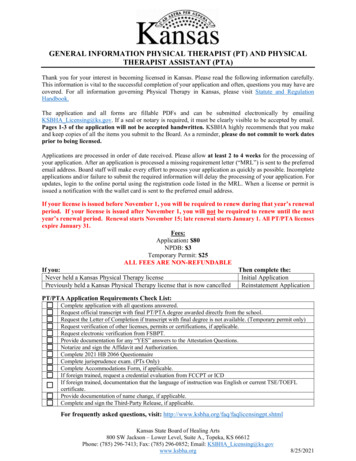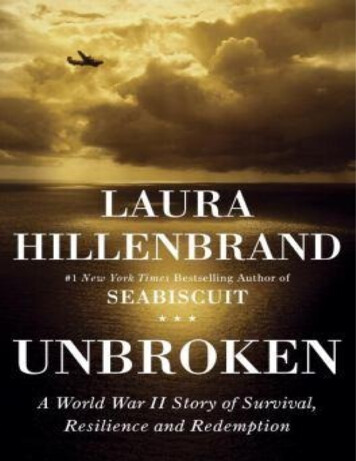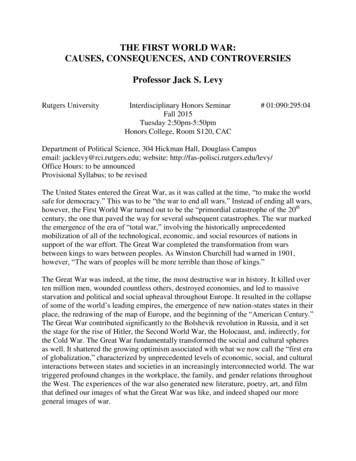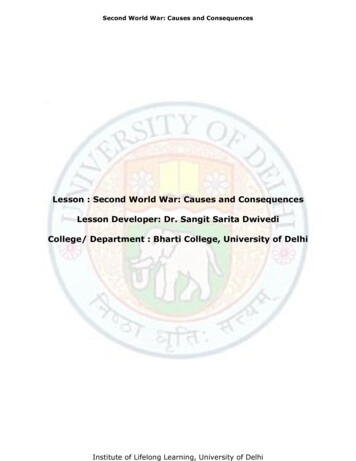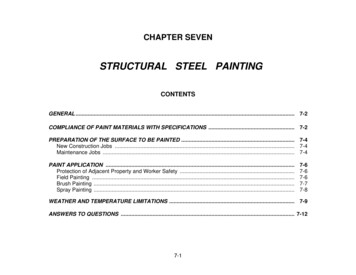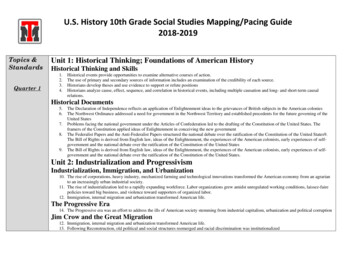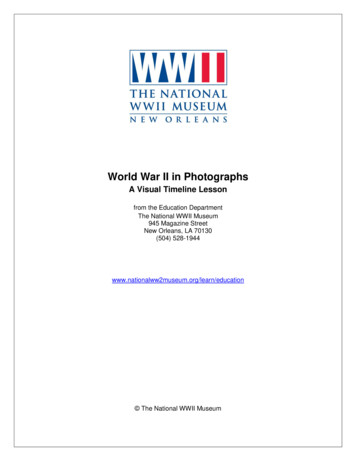
Transcription
World War II in PhotographsA Visual Timeline Lessonfrom the Education DepartmentThe National WWII Museum945 Magazine StreetNew Orleans, LA 70130(504) 528-1944www.nationalww2museum.org/learn/education The National WWII Museum
World War II in PhotographsA Visual Timeline LessonOBJECTIVE:Using critical thinking and observation skills as well as prior knowledge, studentswill gain familiarity or reinforce knowledge of the chronology of WWII by matchingimages, descriptive captions and dates of 25 WWII events. This lesson makes agreat WWII review.GRADE LEVEL:7-12STANDARDS:Content Era 8 (1929-1945) Standard 3—the causes and course of WWIIHistorical Thinking Standard 1—the student thinks chronologically andinterprets data presented in timelinesHistorical Thinking Standard 2—the student comprehends a variety ofhistorical sources including photographsHistorical Thinking Standard 3—the student engages in historical analysis andinterpretation including considering multiple perspectives and analyzing causeand effectCCSS.ELA-Literacy.SL (speaking and listening)—student presents ideas,findings and supporting evidence (conveying a clear and distinct perspective),makes strategic use of digital media and adapts speech to a variety of contextsand tasks demonstrating a command of formal EnglishTIME REQUIREMENT: One class period.DIRECTIONS:Print out the PDF and cut out the photographs, captions and dates. If you plan touse this lesson multiple times, you may wish to laminate each for durability.CAPTIONSPHOTOSDATESThere are several ways to implement this lesson, all of which involve variouslevels of matching photos, captions and dates. Choose the method that worksbest with your students based on their skill and knowledge levels, or make upyour own way. However you use the timeline elements, start by having studentswrite down everything they can tell about their photographs [student worksheetincluded below]. Make sure they indicate whether their descriptions come fromwhat they can see or from what they previously knew about WWII. Informstudents that the descriptive captions do not always describe the actualphotographs, but refer to a historic WWII event.1. Give each student or pair of students a random photograph to study. Next, inchronological order, read aloud each caption and have the student with thematching photograph bring it to the front of the class and tape it to the wall orclip it to a string with a clothes pin. You can then affix the dates and captionsWorld War II in Photographs1 The National WWII Museum
to each picture for the class to review.2. With groups of five students, randomly divide the photos, captions and datesamong the groups. Have each group match their photos, captions anddates. Then have all the groups work together to create the full timeline ofphotos. Each group can explain how they were able to match their photos tocaptions and dates.3. For the most fun: randomly distribute one photo, one date and one captionthat don’t match to each student. Then let them try to find their matchingpartners in order to complete the full timeline as a class. This exercise willrequire good teamwork and communication. End the lesson with a discussion of the challenging job historians have ofselecting what facts to include in their history in order to tell the story they think isimportant.ASSESSMENT:Students can be assessed on the accuracy of their photo matching and thequality of their written descriptions. You can also quiz them on the chronologyfollowing the activity.ENRICHMENT:Further activities can include:World War II in Photographs Writing alternate, longer captions for each photo Deciding individually or as a class 5, 10, or 20 other important WWIIdates to add to the timeline and seeking appropriate photos to match Researching one event in more depth and writing a research paper Creating a WWII photo timeline specifically about one topic, i.e. the Warin the Pacific, the Holocaust, African Americans in WWII, Women inWWII, etc.2 The National WWII Museum
List of WWII Timeline Events/Photos#DateEventArea1Sept. 19, 1931Japan invades ManchuriaPacific2Jan. 30, 1933Adolf Hitler becomes Chancellor of GermanyEurope3Nov. 9, 1938Kristallnacht riots across GermanyEurope4Sept. 1, 1939Germany invades Poland; WWII beginsEurope5Sept. 16, 1940US Congress passes first peacetime draftHome Front6March 11, 1941Lend-Lease Act passedHome Front7Dec. 7, 1941Japanese attack on Pearl Harbor8Feb. 19, 1942Home Front9May 4, 1942FDR signs Executive Order 9066 which will lead to JapaneseAmericans being sent to internment campsOffice of Price Administration issues Ration Book One10May 15, 1942WAACs (Women’s Army Auxiliary Corps) createdHome Front11June 4-7, 194212Nov. 8, 1942American naval forces defeat the Japanese navy at the Battle ofMidwayOperation Torch, the Allied invasion of North Africa begins13May 29, 194314June 2, 1943“Rosie the Riveter” appears on the cover of the Saturday EveningPost as a tribute to working women during the WarThe Tuskegee Airmen undertake their first combat mission15June 6, 1944D-Day: Allied Forces come ashore in Normandy, FranceEurope16Oct. 26, 1944Pacific17Dec. 16, 194418Jan. 26, 1945Japanese navy defeated at Leyte Gulf; first use of Kamikazes byJapanBattle of the Bulge, the last German offensive, begins in a frigidnorthern European winterSoviet troops liberate Auschwitz death camp19Feb. 4, 194520Feb. 23, 194521April 25, 194522May 8, 194523Aug. 6-9, 19452425PacificHome FrontPacificEuropeHome FrontEuropeEuropeEuropeWinston Churchill, Franklin Roosevelt and Joseph Stalin meet atYalta to discuss post-war EuropeMarines raise US flag on Mt. Suribachi during the battle for IwoJimaAmerican forces meet up with their Russian allies at the Elbe Riverin GermanyVictory in Europe (V-E) DayEuropePacificSept. 2, 1945The US drops atomic bombs on the Japanese cities of Hiroshimaand NagasakiJapan signs the surrender agreement, officially ending WWIINov. 21, 1945Nuremberg War Crimes Trials of Nazi leaders beginEuropeWorld War II in Photographs3PacificEuropeEuropePacific The National WWII Museum
World War II in PhotographsDirections: Take a close look at your photograph. Pay attention to details. Write down what you see. Indicate if what youwrite about your photograph comes from what you see, what you already know about WWII, or both.World War II in PhotographsDirections: Take a close look at your photograph. Pay attention to details. Write down what you see. Indicate if what youwrite about your photograph comes from what you see, what you already know about WWII, or both.World War II in Photographs4 The National WWII Museum
SEPTEMBER 19, 1931JANUARY 30, 1933NOVEMBER 9, 1938SEPTEMBER 1, 1939SEPTEMBER 16, 1940World War II in Photographs5 The National WWII Museum
MARCH 11, 1941DECEMBER 7, 1941FEBRUARY 19, 1942MAY 4, 1942MAY 15, 1942World War II in Photographs6 The National WWII Museum
JUNE 4-7, 1942NOVEMBER 8, 1942MAY 29, 1943JUNE 2, 1943JUNE 6, 1944World War II in Photographs7 The National WWII Museum
OCTOBER 26, 1944DECEMBER 16, 1944JANUARY 26, 1945FEBRUARY 4, 1945FEBRUARY 23, 1945World War II in Photographs8 The National WWII Museum
APRIL 25, 1945MAY 8, 1945AUGUST 6 and 9, 1945SEPTEMBER 2, 1945NOVEMBER 2, 1945World War II in Photographs9 The National WWII Museum
Japan invades Manchuria, a region of northern China that offers theJapanese much needed natural resources. The lack of forceful reactionfrom the rest of the world emboldens Japan over the next decade.Adolf Hitler, leader of the Nazi Party, becomes chancellor of Germanyand almost immediately begins consolidating his power and imprisoninghis political enemies.Kristallnacht (Night of Broken Glass): a series of coordinated attacksagainst Jews throughout Germany in which homes, shops andsynagogues where burned and 30,000 Jews were arrested and sent toconcentration camps.Germany invades Poland; Great Britain and France honor their pledge tosupport Poland and declare war on Germany; WWII begins.Although not at war, the United States government recognizes thegrowing danger of the growing war in Europe and passes the firstpeacetime draft in American history.At the urging of President Roosevelt, US Congress passes Lend-Lease Act,which provides Great Britain, the only European power left fighting NaziGermany, with much needed war supplies.Japanese naval and air forces attack the US naval base at Pearl Harbor,Hawaii, plunging the United States into WWII.President Roosevelt signs Executive Order 9066, which soon leads to theinternment in isolated camps of more than 110,000 Japanese Americansfor the remainder of the war.World War II in Photographs10 The National WWII Museum
The US Office of Price Administration issues Ration Book Number One toevery American to use when purchasing rationed items, including sugar,coffee, and meat.The Women’s Army Auxiliary Corps (WAAC) is created, giving women anopportunity to serve in the Army. It will later be renamed the Women’sArmy Corps (WAC).American naval forces sink four Japanese aircraft carriers at the decisiveBattle of Midway. From this battle, Japan’s vast Pacific empire begins toshrink.US and British forces begin their amphibious invasion of North Africa(Operation Torch) in their first efforts to retake Axis-held territory.“Rosie the Riveter” appears on the cover of the Saturday Evening Postmagazine as a tribute to women working in defense factories. There willbe 3,000,000 Rosies by 1945.The Tuskegee Airmen, African American pilots trained at TuskegeeAirfield in Alabama, undertake their first combat missions protectingbombers flying over Europe.D-Day: in the largest invasion in WWII, Allied forces come ashore inNormandy, France, breaking through Hitler’s Atlantic Wall and startingthe long road toward Berlin.In the largest naval battle of WWII, the Japanese navy is defeated at theBattle of Leyte Gulf in the Philippines, where Japanese kamikazes (suicidepilots) are used for the first time.World War II in Photographs11 The National WWII Museum
Battle of the Bulge: Germany’s last offensive in Western Europethreatens to push the Americans back toward the Atlantic; the largestand bloodiest battle the Americans fought during WWII.Soviet troops liberate Auschwitz death camp in southern Poland, wherethe Nazis murdered more than one million Jews since 1940. It was one ofsix concentration camps built specifically for killing Jews.British Prime Minister Winston Churchill, US President Franklin Rooseveltand Soviet General Secretary Joseph Stalin meet at Yalta, Soviet Union, todiscuss post-war reorganization of Europe.US Marines raise the flag atop Mount Suribachi on Iwo Jima, four daysinto the 36-day battle for the tiny Japanese-held island.American troops driving eastward into Germany meet up with Soviettroops pushing westward toward Berlin at the Elbe River, signaling thenear collapse of Hitler’s Germany.Victory in Europe (V-E Day) is declared as Germany offers unconditionalsurrender to the Allies.The United States Army Air Force drops two newly developed atomicbombs, one each on the cities of Hiroshima and Nagasaki, utterlydestroying them.Following their announcement of surrender two weeks earlier, Japanesedignitaries sign the official surrender documents aboard the USS Missouribattleship in Tokyo Bay, ending WWII.World War II in Photographs12 The National WWII Museum
The Nuremburg War Crimes Trials of top Nazi political and militaryleaders begins; many of the horrors of the Holocaust are brought to thepublic’s attention.World War II in Photographs13 The National WWII Museum
HA WWII Timeline Lesson from The National WWII Museum
A WWII Timeline Lesson from The National WWII MuseumT
CA WWII Timeline Lesson from The National WWII Museum
A WWII Timeline Lesson from The National WWII MuseumP
A WWII Timeline Lesson from The National WWII MuseumW
A WWII Timeline Lesson from The National WWII MuseumF
A WWII Timeline Lesson from The National WWII MuseumA
A WWII Timeline Lesson from The National WWII MuseumM
A WWII Timeline Lesson from The National WWII MuseumY
A WWII Timeline Lesson from The National WWII MuseumD
A WWII Timeline Lesson from The National WWII MuseumS
QA WWII Timeline Lesson from The National WWII Museum
KA WWII Timeline Lesson from The National WWII Museum
A WWII Timeline Lesson from The National WWII MuseumE
A WWII Timeline Lesson from The National WWII MuseumB
A WWII Timeline Lesson from The National WWII MuseumV
GA WWII Timeline Lesson from The National WWII Museum
A WWII Timeline Lesson from The National WWII MuseumN
A WWII Timeline Lesson from The National WWII MuseumR
A WWII Timeline Lesson from The National WWII MuseumL
A WWII Timeline Lesson from The National WWII MuseumJ
A WWII Timeline Lesson from The National WWII MuseumO
A WWII Timeline Lesson from The National WWII MuseumX
A WWII Timeline Lesson from The National WWII MuseumI
A WWII Timeline Lesson from The National WWII MuseumU
World War II in Photographs A Visual Timeline Lesson from the Education Department The National WWII Museum 945 Magazine Street New Orleans, LA 70130 . DIRECTIONS: Print out the PDF and cut out the photographs, captions and dates. If you plan to use this lesson multiple

